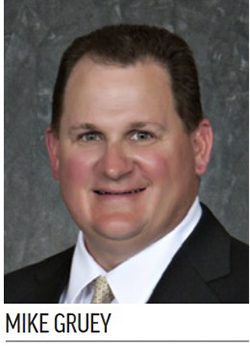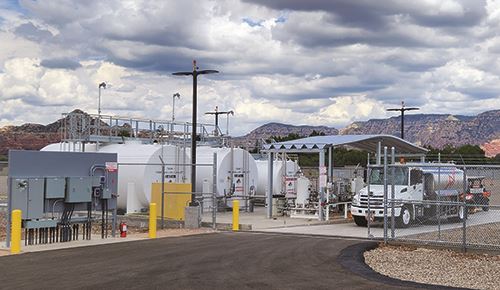Leaders at Sedona Airport (SEZ) in Arizona knew they were on the clock to build a new fuel farm. The decades-old facility at SEZ had a hard time keeping up with customer demand. And, even worse, the fuel tanks themselves were rapidly deteriorating. A long-term solution was needed in the near term.
Leaders at Sedona Airport (SEZ) in Arizona knew they were on the clock to build a new fuel farm. The decades-old facility at SEZ had a hard time keeping up with customer demand. And, even worse, the fuel tanks themselves were rapidly deteriorating. A long-term solution was needed in the near term.
 “Our old fuel farm was 35 years old, and was showing signs of old age and rust,” says Airport Manager Ed Rose. “Our two tanks were listing badly. The left tank was moving 14 inches outward, and the right tank was moving 13 inches outward as well. This put tremendous stress on the plumbing.”
“Our old fuel farm was 35 years old, and was showing signs of old age and rust,” says Airport Manager Ed Rose. “Our two tanks were listing badly. The left tank was moving 14 inches outward, and the right tank was moving 13 inches outward as well. This put tremendous stress on the plumbing.”
Traffic growth at the general aviation airfield added to the problem. “We have a diverse client base, including individual operators, the military, forest service, helicopters for scenic tours, and corporate clients,” Rose chronicles. “We also have 89 hangars rented to clients. As we continued to grow, the fuel demand increased as well.”
That put the airport in a tough situation. “There was a delicate balancing act to make sure we had enough fuel for everyone,” Rose explains. “Three or four large aircraft alone could drain 70% of what we had in our tanks. For instance, last year we sold 1,000, 3,000 and 2,000 gallons in three consecutive days. That was 7,000 gallons, or 70% of our total supply. And that doesn’t include the daily fuel needs of the smaller planes that land here. That was often at least another 1,000 gallons.”
| facts&figures
Project: New Fuel Farm Location: Sedona (AZ) Airport Annual Operations: 33,000 Project Scope: Two 15,000-gallon tanks for Jet A fuel; one 12,000-gallon tank for aviation fuel; one 500-gallon tank for diesel fuel & gasoline Cost: $4.8 million Environmental Assessment: 2017 (approved by FAA in late 2018/early 2019) Environmental Consultant: Coffman Primary Project Consultant/Construction Manager: Dibble Planning/Design Subcontractor, Construction Support: Argus Construction: Aug. 2022-June 2023 General Contractor: KEAR Concrete: Fields Customer Concrete, Masonry & Excavation Pipe Welding Services: Woody’s Metalcraft Fuel System Equipment Supplier: Jet Fuel Specialists Instrumentation System Integrator: JFS Electrical Contractors: Rural Electric; Spectra Electrical Services Key Benefits: Modernized above-ground infrastructure; increased fuel storage capacity; added protection for equipment; code compliance & enhanced safety measures; updated, simplified passive containment system; remote monitoring |
It also was hard to accurately estimate fuel needs, since SEZ doesn’t have regularly scheduled service. And that only added to the stress.
Eventually, Rose solicited help from Dibble, the airport’s current engineering consulting firm. After hearing the airport’s needs and working with engineers from Argus, Dibble recommended that the airport build a new $4 million fuel facility with two 15,000-gallon tanks for Jet A and one 12,000-gallon tank for Avgas. Self-serve pumps were considered, but airport management ultimately decided against them for now. The appropriate nozzles and infrastructure, however, were included to make it easier to install a self-serve station in the future.
With a firm project proposal and cost estimate in hand, Rose requested and secured a loan from the Sedona Oak Creek Airport Authority, the governing board that manages SEZ. “In the past, we always paid for any maintenance projects with our own money,” he explains. “This situation was different. We had funds set aside for several [other] long-term projects in our master plan. But we had to do this one immediately.”
The airport, in discussion with the contractor and engineering consultants, identified tasks SEZ staff could execute to reduce costs. When the project was eventually executed, Rose saved money by using airport maintenance funds and airport personnel for all of the painting and signage.
An environmental assessment completed by Coffman a few years prior had already been approved by the FAA, so Argus and Dibble were able to quickly begin planning. The two companies previously had collaborated on a fuel farm project at Phoenix-Mesa Gateway Airport in 2010.
“We knew they needed this project done relatively quickly, due to the condition of the old fuel tanks,” notes Garrett Gjerstad, one of Argus’ two project managers on the job.
 When engineers evaluated monthly fuel usage, it was apparent that SEZ needed to significantly increase its storage capacity, especially for jet fuel (then only 10,000 gallons). They specified two 15,000-gallon tanks for jet fuel storage, connected with independent issue and receipt piping, as well as a sophisticated monitoring system. One tank would be dedicated to receiving Jet A, and the other would deliver it to the fuel trucks. Engineers also specified a 12,000-gallon tank for Avgas, and the relocation of two 500-gallon tanks for diesel and automotive gasoline for maintenance vehicles.
When engineers evaluated monthly fuel usage, it was apparent that SEZ needed to significantly increase its storage capacity, especially for jet fuel (then only 10,000 gallons). They specified two 15,000-gallon tanks for jet fuel storage, connected with independent issue and receipt piping, as well as a sophisticated monitoring system. One tank would be dedicated to receiving Jet A, and the other would deliver it to the fuel trucks. Engineers also specified a 12,000-gallon tank for Avgas, and the relocation of two 500-gallon tanks for diesel and automotive gasoline for maintenance vehicles.
One key design feature is an automatic tank gauging system that allows airport officials to remotely monitor fuel levels in each tank. The system also sends alerts about problems with the tanks, such as high or low levels, or fuel leaks. To connect the system, the airport had to install an underground high-speed Ethernet line from the electrical room in the terminal to the fuel facility, a distance of about 475 feet.
KEAR was selected as the general contractor through a bid process, and its crews began preliminary surface cleaning and utility work in April 2022.
“We worked closely with both Dibble and Argus on an almost daily basis,” recalls KEAR Project Manager Mike Gruey. “Since about 70% of our company’s work involves aircraft fueling systems, the construction aspect of this new fuel station was something with which we have a lot of experience.”
KEAR also was involved in planning meetings with the airport, Dibble and Argus. “We kept all parties informed about what construction would be done each day, and what equipment, such as high cranes or concrete pumps, would have to be moved around,” says Gruey.
Multiple Delays
Securing the local permits needed before crews could start digging turned out to be the biggest hang-up of the entire $4-plus million project.
 Dibble Project Manager Carmen Rose was point person for the complex, time-consuming process. “I had to work with various officials from Yavapai County, via the county’s online portal. I filled in the application on the portal and submitted it. Then I would receive follow-up questions on the portal that needed to be answered. This process went back-and-forth for several weeks. Eventually, we were able to have an in-person meeting with county and fire department officials, along with most of the airport’s key stakeholders. That seemed to speed things up.”
Dibble Project Manager Carmen Rose was point person for the complex, time-consuming process. “I had to work with various officials from Yavapai County, via the county’s online portal. I filled in the application on the portal and submitted it. Then I would receive follow-up questions on the portal that needed to be answered. This process went back-and-forth for several weeks. Eventually, we were able to have an in-person meeting with county and fire department officials, along with most of the airport’s key stakeholders. That seemed to speed things up.”
The permitting process presented several challenges and delays, adds Seth Newbold, Argus’ other project manager at SEZ. “However, the engineering and construction team did a great job navigating the process and providing the permitting agencies the responses they needed to move the project forward.”
But it still wasn’t smooth sailing. After permits were secured, ground excavation was delayed by bad weather, including rain and even some snow, in late 2022 and early 2023. “It seemed as if we had a big storm every three days or so,” Gruey recalls. “Nothing had time to dry out.”
Not surprisingly, the various delays drove up the project price. “The cost of materials was more than anticipated, but KEAR was very good about keeping us informed about the specifics of these charges, which we communicated to the airport,” says Carmen Rose.
The need for more time and manpower on the job increased Dibble’s cost of services as well.
In the end, the project cost $4.8 million, and the airport absorbed the extra $800,000.
System Training
With the new Ethernet line connecting the fuel farm and terminal building, SEZ personnel can monitor the entire fuel station remotely. However, refueler trucks perform all apron refueling operations at the airport; therefore, the truck drivers are required to know how much fuel they need, as well as tank levels at the station. When drivers fill up their trucks, fuel flow automatically cuts off at the number of gallons they request. Due to the complexity of the new system, all airport personnel involved with fuel delivery received training.
 “This is a more robust, intricate system compared to our old fuel farm,” Newbold explains.
“This is a more robust, intricate system compared to our old fuel farm,” Newbold explains.
KEAR technicians and personnel from Jet Fuel Specialists provided training on the new systems for operations personnel, fuel truck drivers and assorted project team members in full-day increments. The informational sessions were videotaped for future use by the airport.
“Now that the new fuel farm has been in operation for six months or so, there have not been any problems in the fueling operation, so far as I know,” Newbold reports.
Extra Safety Measures
The new fuel farm includes key safety upgrades such as overfill protection, grounding assurance and spill protection with a new catchment system that separates fuel from rainwater runoff.
 During construction, KEAR held daily safety briefings and took special precautions to prevent unauthorized vehicles from entering the worksite. “The new [fuel farm] site is close to aircraft parking lots and taxiways, so we made sure barriers surrounded the work area,” Gruey says. “Fog occasionally hindered visibility, and sometimes there was debris from an overnight storm. We wanted to ensure that everything was clear for that day’s work schedule.”
During construction, KEAR held daily safety briefings and took special precautions to prevent unauthorized vehicles from entering the worksite. “The new [fuel farm] site is close to aircraft parking lots and taxiways, so we made sure barriers surrounded the work area,” Gruey says. “Fog occasionally hindered visibility, and sometimes there was debris from an overnight storm. We wanted to ensure that everything was clear for that day’s work schedule.”
Argus and KEAR worked closely with Dibble to supply information for the FAA 7460 application, detailing possible safety hazards that could affect the airfield. “The only real issue was when and where the high cranes would be used,” says Carmen Rose. “We gave the FAA that information, and the airspace clearance was approved without any problem.”
Final Steps
After all the permits were approved and the weather finally cleared, construction wrapped up during the next three months. Even before the grand opening of the new facility last summer, KEAR worked with airport officials to determine the most efficient way to decommission the old fuel farm.
“We asked them to use as much fuel as possible from the old tanks. Meanwhile, any extra fuel was transferred to the new tanks. All the fuel in the new tanks was tested, and they were ready to go,” Gruey explains.
On June 6, 2023, the old fuel station was decommissioned, and KEAR triple-rinsed, disassembled and removed the old system from the airport. Just six days later, the new fuel farm officially opened.
In the few months the new facility has been operational, Ed Rose has received compliments from customers and Airport Authority officials alike. “Everyone seems very pleased so far,” Rose reports. “Our new facility is up to current codes, and there is better security and safety measures both within the fuel station itself as well as around the perimeter. The new facility should meet our needs for a long time.”
The airport followed up its fuel farm project by seal-coating its runway and select taxiways, providing more notable improvements for customers.



